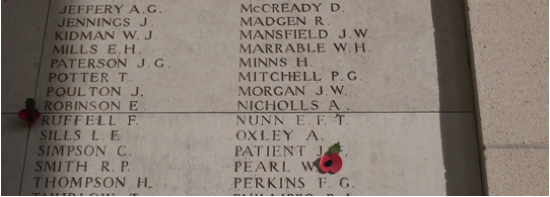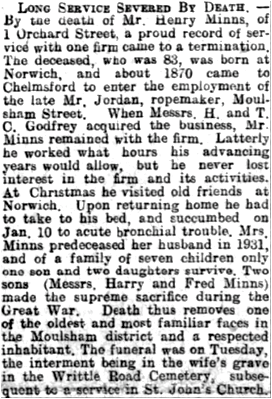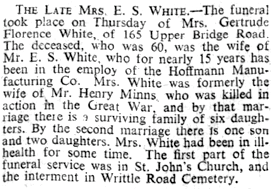Henry Minns was born and brought up in Chelmsford and first served in the army between 1895 and 1903, seeing service in the South African War and in Egypt. He married in 1904 and had eight children and worked at Hoffmann’s bearings factory in Chelmsford. He rejoined the army and landed in France in May 1915 and was shot in the head and killed the following month near Ypres. His home was in Upper Bridge Road. A brother was also shot in the head and killed while serving with the 2nd Battalion, Essex Regiment.
MINNS, HENRY,
Private, 2nd Battalion, Essex Regiment (formerly of the Rifle Brigade)
Henry rejoined the army. enlisted at Chelmsford in to the Essex Regiment, and landed in France on 1st May 1915. Within a few weeks he was killed in action when shot in the head on 19th June 1915 while serving as Private 16521 in the 2nd Battalion of the Essex Regiment. He was aged 37.
News of his death appeared in the Essex Weekly News on 26th June 1915:
“Pte. H. Minns, 2nd Essex, of Chelmsford, was killed on Saturday, being shot through the head. He had seen a lot of active service and was the holder of two medals for the Egyptian campaign, in which he served under Lord Kitchener, and two South African War medals. He went through the siege of Ladysmith and when the present war broke out he re-enlisted. He leaves a widow and eight children.”
A week later the Essex County Chronicle reported:
“Pt. H. Minns, 2nd Essex, of Chelmsford, was killed on June 19, being shot through the head. He had seen a lot of active service, being formerly with the Rifle Brigade, and was the holder of two medals for the Egyptian campaign in which he served under Lord Kitchener, and two South African War medals. He went through the siege of Ladysmith, and when the present war broke out he re-enlisted. He leaves widow and eight children.”
Henry is commemorated on the Ypres (Menin Gate) Memorial, West-Vlaanderen, Belgium, on the Civic Centre Memorial, Chelmsford, on the Hoffmann Manufacturing Company’s War Memorial at Chelmsford Cathedral, and the Moulsham Parish Memorial, St John’s Church, Moulsham. His name on the Menin Gate is adjacent that of William Marrable.

Henry was born in Chelmsford on 9th September 1878, the son of Henry and Mary Ann Minns (nee Newcomb). His father had been born in 1850 in Norwich, Norfolk; his mother in 1857 in Tiptree Heath. They had married in Norwich on 2nd June 1873.
He was baptised at St. John’s Church, Moulsham on 5th October 1878. At that time his father was a rope-maker living in Baddow Road, Chelmsford. Henry’s seven siblings were: Mary Ann Minns, (born in 1874), Rose Eda Minns (c1876-1877), William Minns (1881-1908), Louisa Minns, (1884-1966), Frederick Minns (1887-1916), Rosina Minns (1890-1900), and Percy George Minns (1892-1950). All the children were Chelmsford-born.
The 1881 census found Henry, aged two, living with his parents and elder sister at Bodkins Cottages in what is now Moulsham Street, Chelmsford. His father was a rope-maker at H. & T. C. Godfrey’s works also in Moulsham Street. Later that year they were resident in Baddow Road. Ten years later the family were still in Moulsham, this time at 9 George Street, Chelmsford. Henry’s father employed as a rope-maker, while Henry was a labourer at the rope works.
On 1st November 1895 Henry attested at Warley to join the Rifle Brigade for ‘short service’ (seven years in the colours and five in the reserve). His army record shows that he was 18 years and one month old, employed as a labourer and was then serving in the Militia (Essex Regiment). He was medically examined and passed fit the same day at Warley. He was described as five feet four inches tall, weighed 125 pounds, had a chest of 33 and a half inches expanding to 35 inches, had a fresh complexion, brown eyes and brown hair. He was a member of the Church of England.
Henry joined the Rifle Brigade the following day at Gosport, Hampshire, with the service number 4109. He was posted to the Brigade’s 2nd Battalion on 24th February 1896, and having previously served ‘at Home’ was in Malta from 23rd September 1897. He then served in Egypt from 12th July 1898 (participating in the Nile Expedition), and Crete from 21st September 1898 (participating in the Occupation of Crete). While there he was imprisoned for 28 days in early 1899 for drunkeness on duty, returning to duty on 3rd March 1899. He subsequently served in South Africa from 2nd October 1899 (participating in the Boer War), Egypt from 25th September 1902 and ‘home’ from 18th March 1903. He moved to the Army Reserve on 21st March 1903 and was finally discharged on 31st October 1907.
During that time he received a number of decorations: King;s South Africa Medal with clasps for 1901 and 1902, Queen’s South Africa Medal with clasps for Transvaal and the Defence of Ladysmith, the Nile Expedition 1898 with a clasp for Khartoum, and the Queen’s Sudan Medal 1898.
At the time of the 1901 census Henry’s parents had been living in Blackhorse Yard, off Moulsham Street. His father was still a ropemaker. The household also included Henry’s four youngest siblings, and his brother-in-law Arthur Rolfe who was married to Louisa A. Minns.
Henry married Chelmsford-born Gertrude Florence Heard on 27th February 1904. Their eight children included Gertrude Dorothy Minns (1904-2002), Edith Winifred Minns (1905-1940), Henry Minns (1907-1931), Rose Minns (born in 1909), Lilian Minns (191-1978), Beatrice Minns (1913-1995) and Ivy Minns (1915-2001). All were born in Chelmsford.
When Henry and Rose were christened on 28th March 1908 and 11th August 1909 at St John’s Moulsham respectively, Henry was described as a labourer of 28 Upper Bridge Road, Moulsham. A 1910 street directory listed him at the same address as did the 1911 census, at which point he was 30 years old and employed as a general labourer at Hoffmann’s ball-bearing factory in Chelmsford. The census also listed Henry’s wife and their five children at the address. A street directory from 1913 showed Henry at the same house, by then renumbered as 37 Upper Bridge Road.
In August 1912 Henry appeared at Chelmsford Petty Session accused of being drunk. The Essex County Chronicle reported:
“Henry Minns, a labourer, of Chelmsford, who wore four Army medals, denied a charge of being drunk. P.s. Wood said defendant came out Red Lion Inn, Loudon Road, on the night of Aug. 24th and staggered into the fence, then staggered towards the road, and witness caught him and prevented him from falling. Defendant’s brother came up and assisted him home. Witness went into the inn shortly after 10.30 p.m. but could not say that the defendent was there and saluted him. —P.c. Joslin said defendant was helplessly drunk. —Frederick Marshall, called for the defence, said defendant was sober when he left the inn. Defendant's brother went towards the defendant because the sergeant had taken his name.—Defendant said the police were round him like a picket—he thought he was in the Army. (Laughter).- Marshall added that he did not see defendant stagger. —Frederick Minns said he was with his brother in the Red Lion. Defendant left first, and when witness came out he saw several police there and defendant standing the path with his hands in his pockets. Witness, went across and asked his brother what was the matter, and advised him to go away home "to avoid argument." Defendant, was quite sober. Nothing was known against defendant, who was fined 2s. 6d. and 4s. costs.”



He was entitled to the 1914-15 Star, British War Medal, and Victory Medal.
Henry’s brother Frederick Minns was killed on 1st July 1916 at the start of the Battle of the Somme.
Henry’s widow married Ernest Sidney White early in 1918 and they subsequently lived at 165 Upper Bridge Road. She died in 1940, aged 60. The 1918 register of electors showed Henry’s parents at 19 Grove Road in Chelmsford. His mother died in 1931, aged 73; his father died in 1934, aged 83.
The Minns’ old home at 37 Upper Bridge Road was demolished around 1947.
131129
